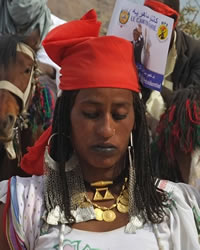Zaghawa, Arabized in Sudan

Photo Source:
Zaghawa Bour - Wikimedia
Creative Commons
|
Send Joshua Project a map of this people group.
|
| People Name: | Zaghawa, Arabized |
| Country: | Sudan |
| 10/40 Window: | Yes |
| Population: | 176,000 |
| World Population: | 176,000 |
| Primary Language: | Arabic, Sudanese |
| Primary Religion: | Islam |
| Christian Adherents: | 0.00 % |
| Evangelicals: | 0.00 % |
| Scripture: | New Testament |
| Ministry Resources: | Yes |
| Jesus Film: | Yes |
| Audio Recordings: | Yes |
| People Cluster: | Kanuri-Saharan |
| Affinity Bloc: | Sub-Saharan Peoples |
| Progress Level: |
|
Introduction / History
Arabization of the African peoples of Sudan began in the 1300s. The country has been growing more Arab and less African ever since. Sudan is a mixture of Arabic culture from the north and sub-Saharan African culture from the south.
What Are Their Lives Like?
Arabic culture is dominant, and many of the African peoples, including the Zaghawa, learn Arabic and live like Arabs. Being more “Arab” than “African” allows people to hold political and economic power in Sudan. This ongoing pressure to accommodate is causing the Zaghawa to abandon their historical culture and become Arabized.
What Are Their Beliefs?
As the Arabized Zaghawa increasingly identify with the Islamic religious system, they become closed to the gospel.
What Are Their Needs?
Arabized Zaghawas need to have their identity in Jesus Christ rather than their ethnicity.
Prayer Points
Pray for the Lord to provide for the physical and spiritual needs of the Arabized Zaghawas in Sudan in such a way that they will understand what he offers his children.Pray for workers to go to them and share God's love.Pray for the Arabized Zaghawa to be open to the word of God.Pray for a Holy Spirit-directed movement to Christ among this group.